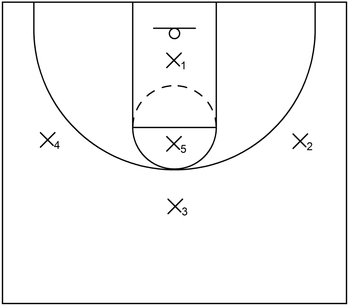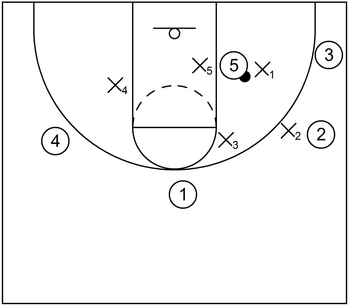What is the 1-3-1 zone defense in basketball
The 1-3-1 zone defense is a basketball defensive strategy that seeks to disrupt offensive scoring opportunities by influencing contested jump shots and limiting dribble penetration, while executing solid on-ball defense.
What is an example of the initial formation for the 1-3-1 zone defense

This is an example of the initial formation for the 1-3-1 zone. X3 starts at the top above the three-point line. X2 and X4 start near the wings. X5 starts near the high post and X1 starts near the basket in the lane.
What are the general responsibilities of the defenders within the 1-3-1 zone defense
The responsibilities of X3 are to provide initial defensive pressure and attempt to influence the ball handler towards one side of the floor as a method of disrupting the offense.
Additionally, in certain instances, X3 could also help limit middle dribble penetration from the wing areas.
The responsibilities of X2 and X4 are to defend the wing areas and closeout on potential shooters if necessary. Also, in some instances, X2 and X4 could help limit middle dribble penetration from the corner.
The responsibilities of X5 are to cover the high post area and prevent high post entry passes when necessary. Additionally, X5 could defend against low post players as well.
The responsibilities of X1 are to primarily defend the corner areas. Furthermore, if a low post player receives the ball near the post block, then X1 could also help with a double team on that low post player.
It should also be noted that X1 is usually the point guard or another player that possesses an above average amount of speed/quickness, which will allow that same player the capability to closeout to the corners.
What are advantages of 1-3-1 zone defense
One particular advantage of the 1-3-1 zone defense is that the defender at the top executes defensive pressure against the player in possession of the ball.
When this occurs, the pressure could potentially cause the ball handler to play faster than usual, which in turn could lead to offensive disruption and eventual turnovers.
Additionally, the zone defenders that are positioned near the wings could place a hand into the passing lanes to limit or prevent easy wing entry passes by the ball handler at the top.
When this happens, the offensive team may have to initiate a different type of half court set than the original, which could also disrupt the flow of the offense.
Another advantage is that there is usually a defender near the high post areas which makes it much more difficult to limit the effectiveness of the zone defense by getting the ball into the middle, either by dribble penetration or via a high post entry pass.
What is a disadvantage of 1-3-1 zone defense
One general disadvantage of the 1-3-1 zone defense is that it may not be as useful or simply ineffective against teams with above average shooters, especially from the corners behind the three-point line.
Basically, if an offensive player with good shooting ability is near one of the wings, then this will usually not be an issue because there is typically a zone defender positioned near those wing areas, at least most of the time.
However, if an offensive player with good shooting skills is near one of the corners, then this could become a potential issue because the corners are usually the most vulnerable spots within the 1-3-1 zone defense.
The reason this could become a problem is because the defender in the back of the zone has the responsibility of covering the corner spots.
However, if that same defender is not able to quickly execute a defensive closeout for whatever reason, then that could give the offensive team an opportunity to take an uncontested corner jump shot, particularly from three-point range.
What are examples of the 1-3-1 zone defense
Example 1

This is an example of the 1-3-1 zone defense with the ball near the top and the offensive team set up in a 2-1-2 formation.
When that happens, X1 applies defensive pressure and attempts to influence 1 towards the right side of the court.
At the same time, X2 and X4 cover the wing areas, X5 denies any entry passes into the high post, and X1 stays near the basket for the time being.
Example 2

This is an example of the 1-3-1 zone defense with the ball near the right side wing area. When that occurs, X2 covers the wing area while X3 could drop back towards the high post elbow to limit or deny dribble penetration towards the middle.
X5 should drop back to cover the low post area or protect the basket near the center of the lane. For this scenario, 5 is near the right side low post area so X5 should defend against that offensive player.
However, it should be noted that even if 5 was not near the low post area, X5 should still drop back to protect the basket in the lane.
For example, if 5 remained near the high post while the ball was near the wing area, X5 would drop back towards the basket and then X3 would deny the high post entry pass.
Additionally, X1 could stand in the gap between the low post and the corner and be prepared to closeout if the ball were to get passed to the corner.
Finally, X4 could drop back near the weak side mid-post area to watch for any possible basket cuts by 4. Also, X4 should also be ready to closeout if 4 were to receive a skip pass from 2.
Example 3

This is an example of the 1-3-1 zone defense with the ball in the corner. When that occurs, X1 covers the corner and could contest a potential jump shot if necessary.
Also, X2 could help guard against middle dribble penetration while still ready to closeout if 2 were to receive the ball from 3. In addition to that, X3 continues to guard near the high post elbow while X4 continues to cover the weak side.
Example 4

This is an example of the 1-3-1 zone defense with the basketball near the low post area. When that happens, X5 executes low post defense against 5.
At the same time, X1 helps double team the low post to influence 5 to pass the ball back towards the top, wing, or corner areas.
X2 continues to cover the wing area while X3 and X4 continue to cover the high post area and weak side respectively.